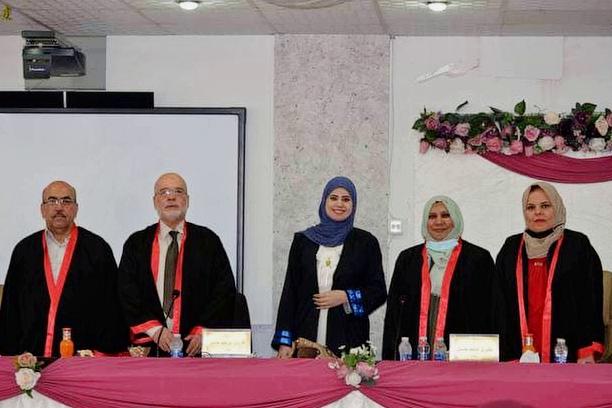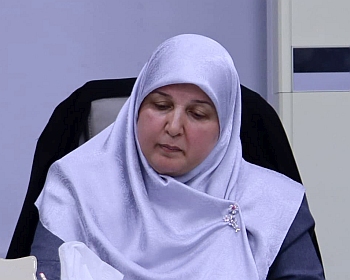ناقش قسم الفيزياء في كلية التربية للعلوم الصرفة (ابن الهيثم) رسالة الماجستير الموسومة (إزالة التوسيع في ملف خطوط حيود الأشعة السينية لأوكسيد الزركانيوم واوكسيد القصدير باستخدام طريقة تحليل خطوط الحيود) للطالبة (سلمى باسم عبد العباس) التي انجتها تحت اشراف التدريسي في القسم (أ.د. خالد هلال حربي) زنزقشت من قبل أعضاء لجنة المناقشة المبينة أسمائهم فيما يأتي :
-
أ.د. بشرى هاشم حسين (رئيسا)
-
أ.م.د. فاروق ابراهيم حسين (عضوا)
-
أ.م.د. اسيل مصطفى عبد المجيد (عضوا)
-
أ.د. خالد هلال حربي (عضوا ومشرفا)
ويهدف البحث الى :
-
تصحيح حيود الأشعة السينية لجسيمات أكسيد الزركونيوم النانوية.
-
استخدام طريقة العرض المتكامل لحساب الحجم البلوري والانفعال الشبكي لأكسيد الزركونيوم.
-
مقارنة نتائج طريقة العرض المتكامل مع طرق أخرى مثل طريقة شيرر وطريقة شيرر الديناميكية وطريقة شيرير وويلسون.
-
استخدام أوكسيد آخر لدعم النتائج.
-
حساب بعض معالم البنية النانوية.
وتم في هذا العمل تصحيح حيود الأشعة السينية باستخدام معيار السيليكون. واستخدمت طريقة العرض المتكامل لتحليل خطوط حيود الأشعة السينية (111) ، (200) ، (220) ، (311) ، و (400) لأكسيد الزركونيوم ، وكانت قيمة حجم البلورات تساوي (8.2 نانومتر) والانفعال الشبيكه يساوي (0.001955) ومقارنة مع طرق التحليل الأخرى لحساب حجم البلورة والانفعال الشبيكه مثل طريقة شيرر وطريقة شيرر داينميك وصيغتي من طريقة شيرر وويلسون ، حيث كانت النتائج على النحو التالي: الحجم البلوري لطريقة شيرر(6.2 نانومتر) والانفعال الشبيكه (0.0144121) ، طريقة شيرر داينميك بحجم الكريستال (7.5 نانومتر) ، صيغة الأولى لشيررويلسون بحجم الكريستال (8.5 نانومتر) والانفعال الشبيكه (0.001919) ، الصيغة الثانية لشيرر ويلسون بحجم الكريستال (8.9 نانومتر). بعد ذلك تم تحليل حيود الأشعة السينية للخطوط (110) و (101) و (200) و (211) و (220) لجسيمات أكسيد القصدير النانوية لدعم النتائج التي تم الحصول عليها من خلال طرق التحليل أعلاه ، حيث كانت النتائج كما يلي: الحجم البلوري لطريقة العرض المتكاملة (12.3 نانومتر) والانفعال الشبيكه (0.002317) ، وحجم البلورة لطريقة شيرر (13.5 نانومتر) والانفعال الشبيكه (0.008083) ، وطريقة شيرر داينميك بحجم البلورة (11.4 نانومتر) ، صيغة شيرر ويلسون الاولى بحجم بلوري (12.4 نانومتر) والانفعال الشبيكه (0. 001164) ، الصيغة الثانية لـ شيررويلسون بحجم الكريستال (13.5 نانومتر). بالإضافة إلى قياس معلمات الشبيكة مثل مساحة السطح المحددة وشدة الخلع لجميع الخطوط.
وفي نهاية بحثها وبعد مناقشة النتائج التي توصلت اليها الطالبة خلصت الى التوصيات الاتية :
-
دراسة الحجم البلوري والانفعال الشبكي للبلور باستخدام ملف Cauchy ومعرفة الفروق والتشابه مع المظهر الجانبي Gaussian لطريقة العرض المتكاملة.
-
تطوير طريقة العرض المتكامل لحساب معاملات الشبكة الأخرى مثل الإجهاد ، مؤشر التشكل ، والطاقة اللازمة لحدوث تشوه الشبكة.
-
دراسة الخواص الميكانيكية لـ ZrO2 و SnO2 بتقنية مناسبة.
-
استخدام طرق التحليل الأخرى ، مثل طريقة التباين أو الحجم-الانفعال ، لحساب الحجم البلوري والانفعال الشبكي ومقارنة النتائج.
-
دراسة تأثير العوامل الفيزيائية مثل درجة الحرارة على حجم البلورة والانفعال الشبكي.
Elimination the broadening in x-ray diffraction lines profile for ZrO2 and SnO2 by using the analysis of diffraction lines method
By Salma Basim Abdel Abbas Mohsen
Supervised by Prof. Dr. Khalid Hela lHarbbi
The Aim of the Work
-X-ray diffraction correction of zirconium oxide nanoparticles
-Using the integral breadth method to calculate the crystal size and lattice strain of zirconium oxide
– Comparison of the results of the integral breadth method with other methods such as the Scherrer method, the Scherrer dynamic method, the Scherrer and Wilson method
-Use another oxide to support the results
– In addition to the calculation of some parameters of the nano structured
Abstract
In this work, x-ray diffraction has been corrected using a silicon standard. And the integral breadth method was used to analyze the x-ray diffraction lines of (111), (200), (220), (311), and (400) to zirconium oxide nanoparticles value of the crystallite size was equal to (8.2 nm)and the strain was equal to (0.001955).and a comparison with the methods of analysis other for calculation of crystallite size and lattice strain such as Scherrer method, Scherrer dynamic method, and formulas from the Scherrer and Wilson method, where the results were as follows: Scherrer the crystal size (6.2 nm) and lattice strain (0.0144121), Scherrer dynamic method the crystal size ( 7.5 nm), Scheerer Wilson’s first formula the crystal size (8.5 nm)and lattice strain (0.001919), the second formula of Scherrer Wilson the crystal size (8.9 nm). After which the X-ray diffraction analysis of lines (110), (101), (200), (211), and ( 220) for tin oxide nanoparticles to support the results obtained by the above analysis methods, where the results were as follows: the crystal size of the integral breadth method (12.3 nm) and lattice strain (0.002317), Scherrer the crystal size (13.5 nm) and lattice strain (0.008083), Scherrer dynamic method the crystal size (11.4 nm), Scherrer Wilson’s first formula the crystal size (12.4 nm) and lattice strain (0. 001164), the second formula of Scherrer Wilson the crystal size (13.5 nm). As well as measuring the lattice parameters such as the specific surface area(SSA) and the dislocation intensity (δ )of all lines
Suggestions for Future Works
-Study the crystal size and lattice strain of a crystal using the Cauchy profile and find out the differences and similarities with the Gaussian profile of the integral breadth method.
-Development of integral breadth method to calculate other lattice parameters such as stress, morphology index, and energy required for lattice deformation to occur
-Study the mechanical properties of ZrO2 and SnO2 using an appropriate technique
-Using other analysis methods, such as the variance or size-strain method, to calculate the crystal size and lattice strain and compare the results
-Study the effect of physical factors such as temperature on crystal size and lattice strain











